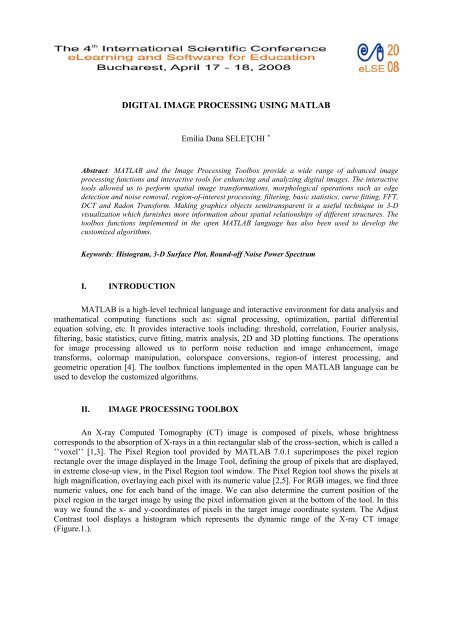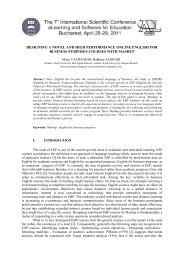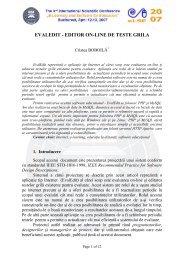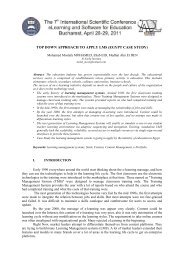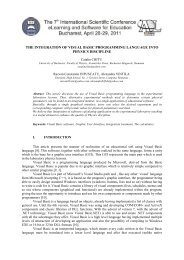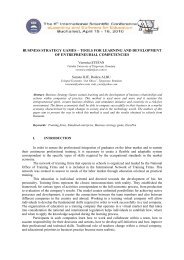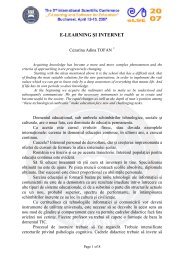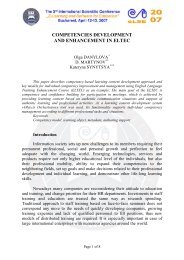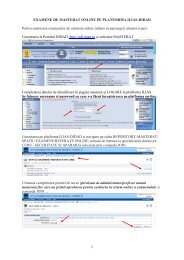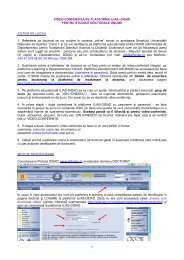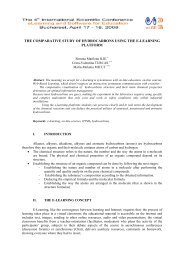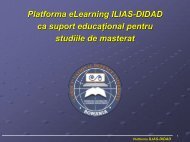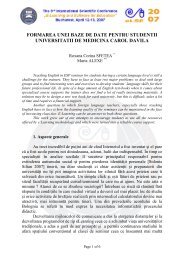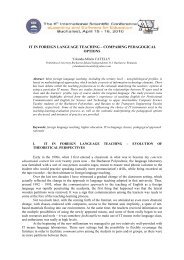digital image processing using matlab
digital image processing using matlab
digital image processing using matlab
- No tags were found...
Create successful ePaper yourself
Turn your PDF publications into a flip-book with our unique Google optimized e-Paper software.
DIGITAL IMAGE PROCESSING USING MATLABEmilia Dana SELEŢCHI ∗Abstract: MATLAB and the Image Processing Toolbox provide a wide range of advanced <strong>image</strong><strong>processing</strong> functions and interactive tools for enhancing and analyzing <strong>digital</strong> <strong>image</strong>s. The interactivetools allowed us to perform spatial <strong>image</strong> transformations, morphological operations such as edgedetection and noise removal, region-of-interest <strong>processing</strong>, filtering, basic statistics, curve fitting, FFT,DCT and Radon Transform. Making graphics objects semitransparent is a useful technique in 3-Dvisualization which furnishes more information about spatial relationships of different structures. Thetoolbox functions implemented in the open MATLAB language has also been used to develop thecustomized algorithms.Keywords: Histogram, 3-D Surface Plot, Round-off Noise Power SpectrumI. INTRODUCTIONMATLAB is a high-level technical language and interactive environment for data analysis andmathematical computing functions such as: signal <strong>processing</strong>, optimization, partial differentialequation solving, etc. It provides interactive tools including: threshold, correlation, Fourier analysis,filtering, basic statistics, curve fitting, matrix analysis, 2D and 3D plotting functions. The operationsfor <strong>image</strong> <strong>processing</strong> allowed us to perform noise reduction and <strong>image</strong> enhancement, <strong>image</strong>transforms, colormap manipulation, colorspace conversions, region-of interest <strong>processing</strong>, andgeometric operation [4]. The toolbox functions implemented in the open MATLAB language can beused to develop the customized algorithms.II.IMAGE PROCESSING TOOLBOXAn X-ray Computed Tomography (CT) <strong>image</strong> is composed of pixels, whose brightnesscorresponds to the absorption of X-rays in a thin rectangular slab of the cross-section, which is called a’’voxel’’ [1,3]. The Pixel Region tool provided by MATLAB 7.0.1 superimposes the pixel regionrectangle over the <strong>image</strong> displayed in the Image Tool, defining the group of pixels that are displayed,in extreme close-up view, in the Pixel Region tool window. The Pixel Region tool shows the pixels athigh magnification, overlaying each pixel with its numeric value [2,5]. For RGB <strong>image</strong>s, we find threenumeric values, one for each band of the <strong>image</strong>. We can also determine the current position of thepixel region in the target <strong>image</strong> by <strong>using</strong> the pixel information given at the bottom of the tool. In thisway we found the x- and y-coordinates of pixels in the target <strong>image</strong> coordinate system. The AdjustContrast tool displays a histogram which represents the dynamic range of the X-ray CT <strong>image</strong>(Figure.1.).
Figure 1. Pixel Region of an X-ray CT scan and the Adjust Contrast ToolThe Image Processing Toolbox provide a reference-standard algorithms and graphical tools for <strong>image</strong>analysis tasks including: edge-detection and <strong>image</strong> segmentation algorithms, <strong>image</strong> transformation,measuring <strong>image</strong> features, and statistical functions such as: mean, median standard deviation, range,etc., (Figure. 2.)Figure 2. Data statistics of an X-ray CT scan performed by MATLAB 7.0.1.III.PLOT TOOLSMATLAB provides a collection of plotting tools to generate various types of graphs,displaying the <strong>image</strong> histogram or plotting the profile of intensity values (Fig. 3.a,b). For example:>>plot (Histogram, 'DisplayName', 'Histogram'); figure(gcf)
Figure 3. a. - The Histogram of X-ray CT <strong>image</strong> and the plot fits (significant digits: 2). A cubic fitting function isthe best-fit model for histogram data plot. The fit curve was plotted as a magenta line through the data plot.Area Graph of X-ray CT brain scan displays the elements in a variable as one or more curves and fillsthe area beneath each curve. For example:>> area (brain_scan, 'DisplayName', ' brain_scan '); figure(gcf)>> colormap hsvcolorbarFigure 3.b. Area Graph of X-ray CT brain scanThe 3-D Surface Plot generates a matrix as a surface (Figures 4. a, b, c, d). We can also make thefaces of a surface transparent to a varying degree. Transparency (referred to as the alpha value) can bespecified for the whole 3D-object or can be based on an alphamap, which behaves in a way analogousto colormaps (Figures 4. a, b). For example:>> surfc (Histogram, 'DisplayName', 'Histogram'); figure(gcf)>>colormap hsvalpha(.0)Figure 4.a. 3D Surface Plot of x-ray CT brain scan generated with histogram values, alpha(.0)
colormap hsvalpha(.4)Figure 4.b. 3D Surface Plot of x-ray CT brain scan generated with histogram values, alpha(.4)The ’’meshgrid’ function is extremely useful for computing a function of two Cartesiancoordinates. It transforms the domain specified by a single vector or two vectors x and y into matricesX and Y for use in evaluating functions of two variables. The rows of X are copies of the vector x andthe columns of Y are copies of the vector y (Figure 4.c). For example:> >mesh(Histogram, 'DisplayName', ' Histogram','EdgeColor','black'); figure(gcf)Figure 4.c. - 3D Surface Plot of x-ray CT brain scan generated with histogram values, mesh3-D Surface Plot with Contour (Surfc) displays a matrix as a surface with contour plotbelow. ’’Lighting’’ is the technique of illuminating an object with a directional light source. Thistechnique can make subtle differences in surface shape easier to see. ’’Lighting’’ <strong>processing</strong> can alsobe used to add realism to three-dimensional graphs. This example uses the same surface as theprevious examples, but colors it yellow and removes the mesh lines (Figure 4.d.). For example:>>surfc (Histogram, 'DisplayName', ' Histogram','FaceColor','yellow','EdgeColor','none'); figure(gcf)camlight left; lighting phongFigure 4.d. Surface Plot of x-ray CT brain scan generated with histogram values, lightening
The ’’Image’’ creates an X-ray CT <strong>image</strong> graphics object by interpreting each element in amatrix as an index into the figure's colormap or directly as RGB values, depending on the dataspecified (Figure 5.a.).> > <strong>image</strong> (brain_scan); figure(gcf)The ’’Image’’ with Colormap Scaling (’’<strong>image</strong>sc’’ function) displays an X-ray CT <strong>image</strong>and scale to use full colormap. MATLAB supports a number of colormaps. A colormap is an m-by-3matrix of real numbers between 0.0 and 1.0. Each row is an RGB vector that defines one color. ,,Jet’’ranges from blue to red, and passes through the colors cyan, yellow, and orange. It is a variation of thehsv (hue, saturation, value) colormap (Figure 5.b.). For example:> > <strong>image</strong>sc (brain_scan); figure(gcf)a) b)Figure 5Contour Plot is useful for delineating organ boundaries in <strong>image</strong>s. It displays isolines of a surfacerepresented by a matrix (Figure 6.). For example:> > contour (brain_scan, 'DisplayName', 'brain_scan', 'ZDataSource', 'brain_scan'); figure(gcf)Figure 6. - Contour Plot of X-ray CT brain scanThe ezsurfc(f) or surfc function creates a graph of f(x,y), where f is a string that represents amathematical function of two variables, such as x and y (Figure 7.).> > surfc (brain_scan, 'DisplayName', 'brain_scan'); figure(gcf)
Figure 7 – Surfc on X-ray CT brain scanThe contour3 function creates a three-dimensional contour plot of a surface defined on a rectangulargrid (Figure 8.). For example:>> contour3 (brain_scan); figure(gcf)Figure 8. – Contour3 on X-ray CT brain scan3-D Lit Surface Plot (Surface plot with colormap-based lighting, surfl function) displays a shadedsurface based on a combination of ambient, diffuse, and specular lighting models (Figure 9.). Forexample:> > surfl (brain_scan); figure(gcf)Figure 9. - 3D Lit Surface Plot of X-ray CT brain scanThe 3-D Ribbon Graph of Matrix displays a matrix by graphing the columns as segmented strips(Figure 10.). For example:
ibbon (brain_scan); figure(gcf)Fig ure 10. - The 3-D Ribbon Graph of X-ray CT brain scanIV. FILTER VISSUALIZATION TOOL (FVTool )Filter Visualization Tool (FVTool) computes the magnitude response of the <strong>digital</strong> filterdefined with numerator, b and denominator, a. By <strong>using</strong> FVTool we can display the phase response,group delay response, impulse response, step response, pole/zero plot, filter coefficients and round-offnoise power spectrum.(Figures: 11, 12, 13, 14, 15, 16 and 17).Figure 11. Magnitude and Phase Response - Frequency scale: a) linear, b) logFigure 12. Group Delay Response - Frequency scale: a) linear, b) log
Figure 13. Phase Delay Response - Frequency scale: a) linear, b) logFigure 14. (a) Impulse Response (b) Pole/Zero PlotFigure 15. Step Response (a) Default (b) Specify Length: 50Figure 16. Magnitude Response Estimate- Frequency scale: a) linear, b) log
Figure 17. Magnitude Response and Round-off Noise Power Spectrum- Frequency scale: a) linear, b) logV. CONCLUDING REMARKSMATLAB provide functions and interactive tools for enhancing and analyzing <strong>digital</strong> <strong>image</strong>sand developing <strong>image</strong> <strong>processing</strong> algorithms. MATLAB visualization tools let us to represent theinformation contained in the X-ray CT <strong>image</strong> data through histograms, contour plots, pixel regions,transparent overlays, and <strong>image</strong>s texture-mapped onto surfaces.The Signal Processing Toolbox (SPTool) provides a suite of interactive graphical userinterfaces for: Signal plotting and analysis, spectral analysis and filter visualization: signal plotting andanalysis, spectral analysis and filtering signals.BIBLIOGRAPHY[1] E.G. Bistriceanu - Principiile Matematematice şi Fizice ale Tomografiei Computerizate,Matrix ROM, Bucureşti, 1996.[2] B. Hahn. D.T. Valentine – Essential MATLAB for Engineers and Scientists, Elsevier (Thirdedition), 2007.[3] Webb, S.- The Physics of Medical Imaging, Institute of Physics Publishing, London.[4] ImageJ – 1.37[5] MATLAB 7.0.1. – The Language of Technical Computing, The MathWorks, Inc., 2005.∗ PhD - University of Bucharest, Faculty of Physics, Bucharest, Romania , E-mail: seletchi@gmail.com


